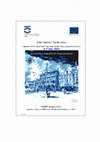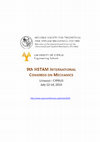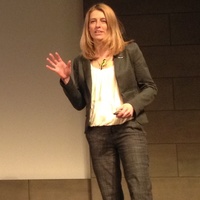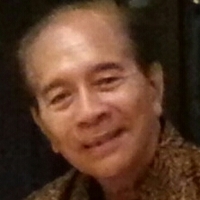Papers by Georgia Foutsitzi

In smart structural applications, multi-layered piezocomposite plates are very common for the stu... more In smart structural applications, multi-layered piezocomposite plates are very common for the study of active control applications. In this paper a finite element formulation is presented to model the static and dynamic response of laminated composite plates containing integrated piezoelectric sensors and actuators subjected to electrical and mechanical loadings. The formulation is based on a third order shear deformation theory and Hamilton’s principle. A nine-noded \(C^0\) plate element is implemented for the analysis. The element was developed to include stiffness and the electromechanical coupling of the piezoelectric sensor/actuator layers. The electric potential is assumed to vary linearly through the thickness for each piezoelectric sublayer. The model is validated by comparing with existing results documented in the literature. A displacement and optimal LQR control algorithm is used for the active control of the static deflection and of the dynamic response of the plates wi...

2021 6th South-East Europe Design Automation, Computer Engineering, Computer Networks and Social Media Conference (SEEDA-CECNSM), 2021
In this work, the optimal design of an unmanned aerial vehicle (UAV) wing spar by multi-objective... more In this work, the optimal design of an unmanned aerial vehicle (UAV) wing spar by multi-objective optimization genetic algorithms is studied. An electromechanical finite element model (FEM) for piezolaminated bimorph cantilever structure with embedded piezoceramics is used combined with multiobjective genetic algorithms. The FEM formulation is based on laminated plate theory combined with the first-order shear deformation theory (FSDT) for which each piezoelectric layer has one additional electrical degree of freedom. Non-dominated Sorting Genetic Algorithm II (NSGA-II), Non-dominated Sorting Genetic Algorithm III (NSGA-III) and Generalized Differential Evolution 3 (GDE3) algorithm have been used to optimize the geometric and electric circuit parameters of a UAV generator for maximum power output and minimum mass added by the embedded piezoceramics. It is shown that the proposed algorithms are effective in developing optimal Pareto front curves for maximum electrical power output of...

Approximation and Optimization, 2019
In the present chapter, optimal design problems related to smart composites are investigated. Fir... more In the present chapter, optimal design problems related to smart composites are investigated. First, the mechanical properties of a smart composite can be tailored to meet required specifications. Beyond classical shape and layout optimization related to the layers of a composite, pointwise optimization leading to functionally graded composites or even topology optimization can be applied. A cantilever beam with two materials is briefly presented. Furthermore, the control subsystem has several parameters to be optimized: number and position of sensors and actuators, as well as the parameters of the controller. Here, some basic techniques regarding soft control based on fuzzy and neuro-fuzzy strategies are presented, along with optimization options and methods which can be used for the fine-tuning of the parameters of the system. The main concept of the present chapter is to provide stimuli to those who deal with design, optimization, and control issues on smart structures.
In the present investigation, an optimization algorithm inspired by nature is used for the fine-t... more In the present investigation, an optimization algorithm inspired by nature is used for the fine-tuning of the parameters of a fuzzy controller used for the vibration suppression of a smart composite plate. More specifically, the particle swarm optimization method is chosen. This method is a population based optimization algorithm. It is a totally stochastic technique that simulates the movement of particles towards the optimum solution. The tuned controllers, which resulted from the optimization process, are tested for a wide range of different external loadings in order to examine the comprehensiveness of the proposed method in various excitation cases. The final results are compared with the ones from previous investigations of our team.
Journal of Sound and Vibration
Proceedings of the 5th International Conference on Computational Methods in Structural Dynamics and Earthquake Engineering (COMPDYN 2015), 2015
Proceedings of the VII European Congress on Computational Methods in Applied Sciences and Engineering (ECCOMAS Congress 2016), 2016
An efficient strategy for calculation of delaminations in composite beams and intelligent structu... more An efficient strategy for calculation of delaminations in composite beams and intelligent structures is used in order to quantify structural uncertainties within a finite element model of a piezocomposite (multilayered plate theory). Furthermore the dynamical system is connected with robust and neurofuzzy control. The problem of positioning of actuators and sensors has been investigated. Model based simulations of increasing complexity illustrate some of the attractive features of the strategy in terms of accuracy as well as computational cost. This shows the possibility of using such strategies for the development of smart structural and systems.
Springer Proceedings in Mathematics & Statistics, 2015
In this paper multi-objective genetic algorithms have been used to search for the optimal placeme... more In this paper multi-objective genetic algorithms have been used to search for the optimal placement of the piezoelectric sensors and actuators bonded on smart beams. A finite element method based on Timoshenko beam theory is used accounting for the piezoelectric layers. The discrete optimal sensor and actuator location problem is formulated in the framework of a zero-one optimization problem with multi-objective functions as performance measures. A cantilever beam example is considered to demonstrate the performance of the selected multi-objective genetic algorithm which is NSGAII. It is shown that the proposed algorithm is effective in developing optimal Pareto front curves for optimal placement and number of actuators and sensors such that the performance on dynamic responses is also satisfied.

This paper presents the design of a vibration control mechanism for a two-dimensional multistory ... more This paper presents the design of a vibration control mechanism for a two-dimensional multistory building subjected to wind excitations. The dynamic model of the structure is obtained by finite element approximation. The behavior of the structure is described by simplified linear equations. A linear quadratic regulator and an 2 H optimal control method are used for the suppression of the adverse vibration effects. Structured uncertainties are considered to reflect the errors between the model and the reality. To accommodate directly the plant uncertainties and to obtain a best possible performance in the face of uncertainties a robust H ∞ optimal control for active control structure is used. The two latter robust controllers take into account as well incompleteness of the measured information, a fact that can not be neglected in civil engineering, and lead to applicable designs of smart structures. The numerical simulation shows that sufficient vibration suppression can be achieved by means of the proposed general methods.

A finite element analysis for modelling the dynamic response of laminate composite plates with ad... more A finite element analysis for modelling the dynamic response of laminate composite plates with adhesive and piezoelectric layers is presented. The formulation is based on a partial layerwise displacement theory which includes the peel and shear stiffness of the adhesive. The layers are modeled using the first-order shear deformation plate theory. Numerical examples show that the present model can well predict both the global and local responses such as mechanical displacements, modal frequencies, all in good agreement with those from the literature. 1 INTRODUCTION Recent interest in high-precision machining and lightweight structures with superior structural performance has prompted development in smart or intelligent structures. Piezoelectric materials are widely used in both sensor and actuator applications. They may be embedded in a structure providing the adaptability and smart characteristics required. The paper presents some recent results in the analysis of laminated plates with surface-bonded piezoelectric sensor and actuator layers and adhesive layers between them. Original ideas in previous paper [1] have been extended to the static and dynamic analysis of laminated composite plates. An adhesively bonded, laminated element, which includes both peel and shear effects in the adhesive layer, is utilized. A partial layerwise displacement theory and first order shear deformation theory is considered. The influence of the adhesive layer and the layerwise formulation on the static and dynamic responses of beams and plate structures is examined. The model obtained by using the finite elements developed herein is validated by comparing with classical results of composite piezoelectric beams that are based on three-dimensional finite element analysis. Next, the effect of the actuation voltages on the shape control of laminated plates is investigated. Finally, the eigenmodal characteristics have been calculated for three different cases. For the calculation of the reference solutions, commercial finite element code is used. The results can be used, together with optimal control software, for the design of smart structures (cf. previous contributions of the authors in [2]). 2 FINITE ELEMENT ANALYSIS Consider a laminated composite plate bonded with piezoelectric sensor and actuator layers and adhesive layers between them, as shown in Fig 1. The length, width and thickness of the whole plate are denoted by L, b and h, respectively. The finite element analysis is briefly descripted here (more details may be found in [1]). 2.1 The Governing Equations for Piezoelectricity For simplicity of the notation, all the non-adhesive layers will be considered piezoelectric. The linear constitutive equations of each layer can be written as
A finite element formulation for modelling the dynamic response of laminate composite beams with ... more A finite element formulation for modelling the dynamic response of laminate composite beams with bonded viscoelastic and piezoelectric layers is presented. The formulation is based on the Euler-Bernoulli beam theory and Hamilton's principle. The active control of the beam is designed using either the optimal linear quadratic reg ulator strategy or the robust H ∞ control theory. The behavior of the smart structure in the presence of damage in the viscous layer is investigated. The implemented numerical simulation shows the dynamical response of the uncontrolled beam as well as the suppression of the vibrations of the controlled beam.
This paper presents a layerwise modeling approach for smart piezoelectric beams and applications.... more This paper presents a layerwise modeling approach for smart piezoelectric beams and applications. The theoretical development is extended to a finite element discretization. The model is applicable for integration with various optimal control schemes and used in the design of smart structures. Moreover it allows for the investigation of delamination and interlayer damage models, their effects on the structural control as well as the design of robust control schemes and damage identification problems. Index terms-piezoelectric smart beams, finite element analysis, structural control, robust control, delamination.











Uploads
Papers by Georgia Foutsitzi